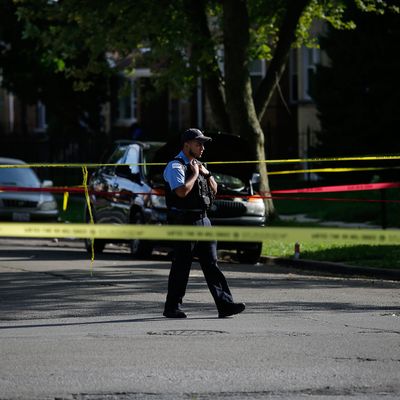
Donald Trump has spent much of his general-election campaign portraying America as a blood-drenched hellscape where marauding bands of undocumented immigrants terrorize the countryside and African-American city dwellers sustain gunshot wounds every time they walk down the street.
Occasionally, the Republican nominee has flavored his demagogic hyperbole with a dash of empiricism. In his convention speech, Trump cited last year’s uptick in the homicide rate of America’s 50 largest cities as evidence that “decades of progress” in public safety had been undermined by the Obama administration’s “rollback of criminal enforcement.”
Of course, that statistic did not actually support Trump’s conclusion — nationally, violent crime has declined under the current president (and Obama has not rolled back “criminal enforcement,” unless suggesting that police should kill fewer unarmed black people qualifies as such). But Trump’s data point was misleading in another, less obvious way: The murder rate did not rise last year in our nation’s 50 largest cities; rather, it jumped so sharply in a few urban centers, the collective rate of those 50 cities went up, despite stagnant — or even falling — homicide rates in the majority of locales.
On Friday, the New York Times published the most comprehensive analysis of last year’s homicide statistics to date. Its findings reinforce the conclusion that our country, as a whole, is not suffering a significant surge in the incidence of murder — but a disconcerting number of its urban centers are.
In 2015, homicide rates rose significantly in 25 of America’s 100 most populous cities — the largest such fraction since 1991, when 36 cities saw their annual murder rates increase, according to the paper’s analysis.
Even among those 25 cities, there were stark disparities in the level of crisis: Half of the entire increase in big-city homicides was concentrated in just seven municipalities — Baltimore, Chicago, Cleveland, Houston, Milwaukee, Nashville, and Washington.
And only in Baltimore was the spike in homicides sharp enough to return the city to a historically high murder rate. While Charm City suffered a historic high of 55 homicides per 100,000 residents in 2015, for the seven cities collectively that figure was 21. Which is significantly lower than it was throughout the 1990s.
Meanwhile, 70 large cities saw their murder rates hold steady in 2015, while 5 saw them fall.
“Cities are obviously heterogeneous,” Robert Sampson, a Harvard social scientist who studies crime trends, told the Times. “There is tremendous variation across the largest cities in basic features such as demographic composition, the concentration of poverty, and segregation that relate to city-level differences in rates of violence.”
There is also considerable heterogeneity within cities. Chicago saw 488 homicides in 2015, the most of any city in the nation. But ten of the city’s neighborhoods had homicide rates of zero last year — while the neighborhoods of Burnside and Fuller Park each suffered rates of over 100, according to the Trace, a digital news outlet that focuses on gun crime.
In light of these statistics, the Trace’s Daniel Kay Hertz argues that America does not have a murder problem so much as a “murder inequality” problem. That term has its drawbacks; no one wants every American neighborhood to experience an equally high crime rate. But it helpfully focuses attention on the fact that last year’s uptick in violent crime did not afflict “America” or “Chicago,” but rather the most disadvantaged neighborhoods in that city and other cities like it.
The seven cities that drove last year’s spike in homicides all have poverty rates above the national average. And it was the most economically disadvantaged — and, often, racially segregated — districts within those cities that saw the greatest bloodshed.
Observing the precise geography of violent crime in America can enable policymakers to identify the idiosyncratic problems facing certain municipalities. For example, during the riots that followed the death of Freddie Gray, looters cleared the inventory of several Baltimore pharmacies. Some experts who spoke with the Times believe the subsequent murder wave was linked to this sudden expansion in the supply of black-market opiates. If this theory holds true, the homicide rate should fall as the supply becomes exhausted.
But understanding homicide as a problem that manifests on the neighborhood level does not prohibit effective policy responses on the federal one. There is a clear correlation between concentrated poverty, racial segregation, and high homicide rates. A genuine anti-crime agenda would aim squarely at reducing the number of neighborhoods defined by those first two conditions. More effective law enforcement will also be required. While there is little evidence that draconian sentences deter crime, the certainty of apprehension absolutely does. When homicides routinely go unpunished, cycles of retaliatory violence proliferate. In Chicago, the neighborhoods with the highest murder rates often have the lowest clearance rates for homicide. So far this year, the city has seen a 50 percent spike in its homicide rate, while its police have solved only 30 percent of murder cases. (In the similarly sized city of Houston, the homicide clearance rate is 56 percent.) Improving clearance rates will require improving the relationship between police and crime-plagued communities. Which, ironically, may require less law enforcement: The Justice Department’s recent report on the Baltimore police found that the department’s “zero tolerance” approach to policing petty crime produced routine violations of residents’ civil rights. That probably isn’t the best strategy for cultivating the cooperative ethos necessary for cracking homicide cases.
A disingenuous anti-crime agenda, on the other hand, would aim to validate white racial anxieties by evoking images of lawless minorities, and then assuage those anxieties with vague promises of “toughness” and impenetrable walls.






























